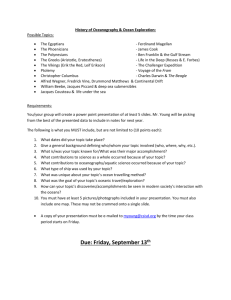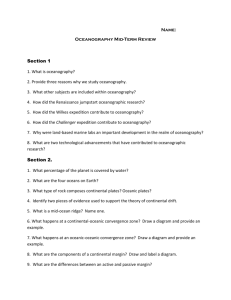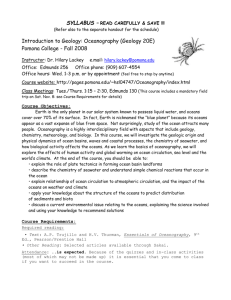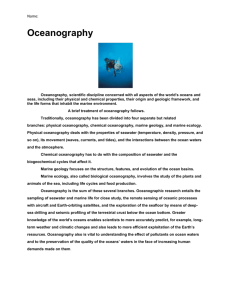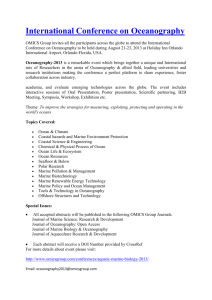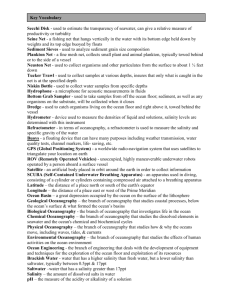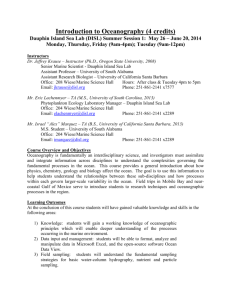Oceanography and the Nature of Science What is Science? Science
advertisement
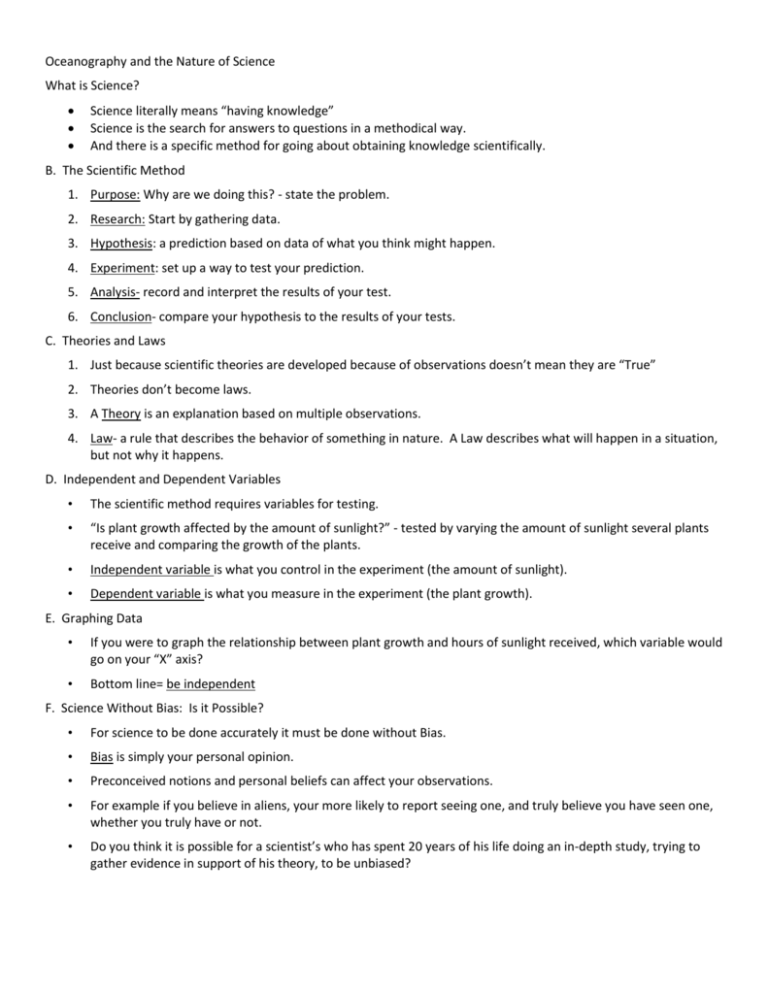
Oceanography and the Nature of Science What is Science? Science literally means “having knowledge” Science is the search for answers to questions in a methodical way. And there is a specific method for going about obtaining knowledge scientifically. B. The Scientific Method 1. Purpose: Why are we doing this? - state the problem. 2. Research: Start by gathering data. 3. Hypothesis: a prediction based on data of what you think might happen. 4. Experiment: set up a way to test your prediction. 5. Analysis- record and interpret the results of your test. 6. Conclusion- compare your hypothesis to the results of your tests. C. Theories and Laws 1. Just because scientific theories are developed because of observations doesn’t mean they are “True” 2. Theories don’t become laws. 3. A Theory is an explanation based on multiple observations. 4. Law- a rule that describes the behavior of something in nature. A Law describes what will happen in a situation, but not why it happens. D. Independent and Dependent Variables • The scientific method requires variables for testing. • “Is plant growth affected by the amount of sunlight?” - tested by varying the amount of sunlight several plants receive and comparing the growth of the plants. • Independent variable is what you control in the experiment (the amount of sunlight). • Dependent variable is what you measure in the experiment (the plant growth). E. Graphing Data • If you were to graph the relationship between plant growth and hours of sunlight received, which variable would go on your “X” axis? • Bottom line= be independent F. Science Without Bias: Is it Possible? • For science to be done accurately it must be done without Bias. • Bias is simply your personal opinion. • Preconceived notions and personal beliefs can affect your observations. • For example if you believe in aliens, your more likely to report seeing one, and truly believe you have seen one, whether you truly have or not. • Do you think it is possible for a scientist’s who has spent 20 years of his life doing an in-depth study, trying to gather evidence in support of his theory, to be unbiased? What is Oceanography? • Oceanography is the study of the ocean using scientific methods of testing and data recording. G. Earth and its Oceans • Earth's surface is mostly water: 71% • How did the oceans form? One theory states: As Earth warmed and partially melted, water locked in the minerals as hydrogen and oxygen were released and carried to the surface by volcanic venting activity (outgassing). Once the hydrogen and oxygen was released into the atmosphere, it combined to become water vapor. As more water was produced, clouds formed and it rained and rained and rained! G. Earth and its Oceans • The presence of water on Earth is due to the “Goldilocks Effect” - Earth is a perfect distance from the sun for water to be liquid on the planet. • Too close, and water would be permanently water vapor. • Too far, and water would be permanently ice. • Liquid water is essential to support life on Earth! I. One World Ocean, 5 Names • All the oceans are interconnected, but we use 5 names to identify the 5 main ocean basins. • They are Pacific, Atlantic, Indian, Arctic, and Southern (formerly the Antarctic). • Label your worksheet and color each ocean a different color. Turn it in when you are finished. J. The Disciplines of Oceanography 1. Oceanography is composed of 4 basic disciplines: 1. Geological Oceanography – Structure and formation of the sea floor 2. Chemical Oceanography - Chemical composition and properties of seawater 3. Physical Oceanography - Waves, tides, currents (all movement) 4. Biological Oceanography - Oceanic life forms J. The Disciplines of Oceanography Using the descriptions, state which area of oceanography the following situations would fit into: (INCLUDE SCENARIO IN YOUR NOTES AND ANSWER) 1. Studying the tides during a moon cycle 2. Testing how much salt is in the waters of the Southern Ocean 3. Studying the mating habits of false killer whales 4. Using sonar to map the sea floor 5. Sampling ocean water and iceburg melt water and comparing their chemical compositions 6. Tracking the ocean currents as they move from the equator to the pole in the Atlantic ocean 7. Sending a ROV to the floor of the Pacific to collect data on depths and underwater trenches 8. Taking a count of the number of species of Clownfish on the Great Barrier Reef


